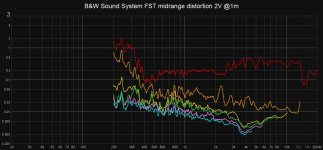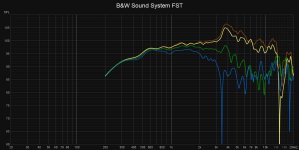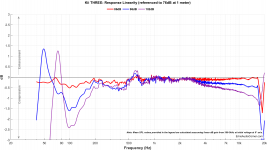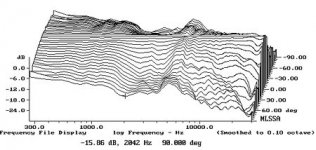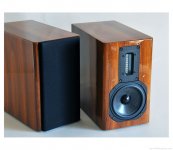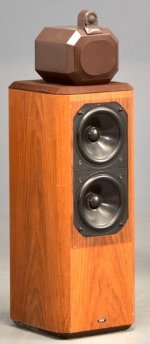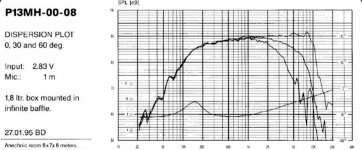I honestly want all of it, both off axis and dynamics. I don't like the term SPL, because I don't listen that loud. I do want the unrestricted dynamic range and that's why its a criteria, plus higher sensitivity drivers tend to sound more open and revealing IMO. If I'm listening to drums, I want to hear the full range at lifelike volume levels when I feel like it. I know better than to ruin my ears with too much too long.3 way front and subwoofers... so 4 way is my best option. I can't see myself living with a speaker where the off-axis response is not almost as good as the on-axis. Then I'd rather live with a few dB less and have a smooth response all over. Quality of sound rather than loudness. A 5" midrange in a fully active system - when it only works from around 500Hz to 2kHz.... plenty loud for me
I get what your are saying because SPL might be mis-interpreted as maximal loudness at all cost. But I use the term SPL as an engineering term.I honestly want all of it, both off axis and dynamics. I don't like the term SPL, because I don't listen that loud. I do want the unrestricted dynamic range and that's why its a criteria, plus higher sensitivity drivers tend to sound more open and revealing IMO. If I'm listening to drums, I want to hear the full range at lifelike volume levels when I feel like it. I know better than to ruin my ears with too much too long.
If you want unlimited dynamics you need to hit high SPL with little to no compression.
The other side of that coin is low distortion.
My son was practising trumpet last night and out of curiosity I pull out the SPL meter and it was hitting 105dB peaks where I was seated (~3m).
It didn’t sound “loud” or “painful” like a lawnmower at a constant 95dB. It just sounded like live trumpet.
If you want the live concert experience in your living room a Sonos speaker or Apple Homepod isn’t going to cut it, even though they play “loud enough” for most people.
Last edited:
There are some surprisingly high dynamic peaks in otherwise unassuming instruments. A lousy little triangle can peak at well over 110 dB and can acoustically overload a decent mic with its narrow and complicated treble peak.
When my son plays his tenor sax, I can see 107 dB peaks with 90 dB average levels measured in pro tools recorded straight through a U87. When played back through my B&W 802s listening in another room, it sounds like he is actually playing live in the room. Thats the type of performance I'm after.
A smaller size mid driver crossed low tends to lack that dynamic capability at lower distortion figures. I find most 5 inch mids need a 400+ 2nd order xover to keep up with a 10+ inch LF driver to avoid audible IM distortion. Without a dedicated midbass driver, a 5 inch mid is likely the best compromise with a smaller HF driver. Its possible to use a 6 - 8 inch mid driver with a larger diameter HF driver allowing a lower xover, especially with a WG.
Long term power compression isn't so much an issue for very short bursts of power. Transient power compression resulting in extreme fluctuations in Le and BL non-linearity through the VC travel range is a problem, specifically with smaller diameter VCs wound on plastic formers. At higher drive levels, the outside edges of the VC windings heat up faster than the center, which is the cause. A shorter, larger diameter VC is better in this regard, preferably with a metal former for better heat transfer and distribution, although most people feel a metallic VC former hurts low level detail retrieval. I prefer fiverglass or titanium VC formers myself, but kapton is ok if not driven too hard for longer periods of time, as it tends to deform and blister under these conditions promoting VC rubbing.
When my son plays his tenor sax, I can see 107 dB peaks with 90 dB average levels measured in pro tools recorded straight through a U87. When played back through my B&W 802s listening in another room, it sounds like he is actually playing live in the room. Thats the type of performance I'm after.
A smaller size mid driver crossed low tends to lack that dynamic capability at lower distortion figures. I find most 5 inch mids need a 400+ 2nd order xover to keep up with a 10+ inch LF driver to avoid audible IM distortion. Without a dedicated midbass driver, a 5 inch mid is likely the best compromise with a smaller HF driver. Its possible to use a 6 - 8 inch mid driver with a larger diameter HF driver allowing a lower xover, especially with a WG.
Long term power compression isn't so much an issue for very short bursts of power. Transient power compression resulting in extreme fluctuations in Le and BL non-linearity through the VC travel range is a problem, specifically with smaller diameter VCs wound on plastic formers. At higher drive levels, the outside edges of the VC windings heat up faster than the center, which is the cause. A shorter, larger diameter VC is better in this regard, preferably with a metal former for better heat transfer and distribution, although most people feel a metallic VC former hurts low level detail retrieval. I prefer fiverglass or titanium VC formers myself, but kapton is ok if not driven too hard for longer periods of time, as it tends to deform and blister under these conditions promoting VC rubbing.
Do you have a picture of those 802?
I have some experience with a custom B&W midrange driver here:
note this is 2V only applied into a 4ohm driver; measured at 1m, on and off axis (0/15/30/45/60 degrees)
also supplied is distortion.
Note the scale:
HD2 ~ 0.2% = -54dB
0.05 % = -66dB
0.02 % = -74dB
That combination of high sensitivity (100dB) and low distortion (below noise floor) cannot be surpassed with a smaller driver
the downside is that it start to beam soon after 1KHz. I would take it up to 1.6-2.5Khz, but B&W take it out to 4…
I have some experience with a custom B&W midrange driver here:
note this is 2V only applied into a 4ohm driver; measured at 1m, on and off axis (0/15/30/45/60 degrees)
also supplied is distortion.
Note the scale:
HD2 ~ 0.2% = -54dB
0.05 % = -66dB
0.02 % = -74dB
That combination of high sensitivity (100dB) and low distortion (below noise floor) cannot be surpassed with a smaller driver
the downside is that it start to beam soon after 1KHz. I would take it up to 1.6-2.5Khz, but B&W take it out to 4…
Attachments
Last edited:
Long term power compression is not important with real music, as demonstrated by Erin Hardison.
@bikinpunk
It's the instantaneous compression that suffers:
Here's everyone's 21C favourite, KEF LS50 Wireless II:
Long term compression:

Short term compression

Now here's a speaker design without fancy DSP for crossover or EQ, but just a single state of the art Purifi 6.5" mid-woofer

@bikinpunk
It's the instantaneous compression that suffers:
Here's everyone's 21C favourite, KEF LS50 Wireless II:
Long term compression:
Short term compression
Now here's a speaker design without fancy DSP for crossover or EQ, but just a single state of the art Purifi 6.5" mid-woofer
Attachments
Last edited:
That's not necessarily a downside, just depends on where you look at it. Yeah, B&W crossed that relatively large midrange driver at 4kHz to a 1" dome that don't have any waveguide. The result is a huge directivity mismatch between the drivers around the crossover region (as we can see below). Objectively speaking, this is far from optimal, but subjectively can be pleasing to someone. Who knows..the downside is that it start to beam soon after 1KHz. I would take it up to 1.6-2.5Khz, but B&W take it out to 4…
B&W 802D
Attachments
Last edited:
Thank you for pointing this outThat's not necessarily a downside, just depends on where you look at it. Yeah, B&W crossed that relatively large midrange driver at 4kHz to a 1" dome that don't have any waveguide. The result is a huge directivity mismatch between the drivers around the crossover region (as we can see below). Objectively speaking, this is far from optimal, but subjectively can be pleasing to someone. Who knows..
B&W 802D
Of course, my opinion is that too.I firmly believe that having a more precise speaker in a more overall nice room to be in - is the better choice.
See my 'viral project thread' for proof
https://www.diyaudio.com/community/threads/viral-projects-sort-of.351475/
https://www.diyaudio.com/community/threads/viral-projects-sort-of.351475/
This was great experience. These speakers were placed in large, well acoustically treated room, and despite of the all desigh an technical flaws they were sounding quite ok.
Making new crossover was not easy. There was not much space in the plinths, so I went with tweeter and midrange crossover split to separate pcbs and stacked vertically. So I wanted to keep crossover simple.
Midrange tweeter Fc is still higher then intended but tweeter did not allow lower.
Compromises had to be made still the result brough clear improvement.
That is a nice driver. Very underrated. Mids are very snappy, open and revealing, plus low end is full for such a small driver. As a dedicated mid, it would do well with a planar or ribbon. I've used it in a BBC LS3 clone with TW034.I use 300 to 3000, just because that's what my active crossover does.
With aurum cantus ac-130f1.
Another highly recommended mid.
I would have liked use that one but it is NLA but in the Jeff Bagby (rip) Meniscus kit iirc...I use 300 to 3000, just because that's what my active crossover does.
With aurum cantus ac-130f1.
Another highly recommended mid.
This midwoof has a crazy good reputation.
These are what I have (not my actual set, but the same model). We had to open up our living room wall to repair ac ductwork... what a mess.Do you have a picture of those 802?
I have some experience with a custom B&W midrange driver here:
note this is 2V only applied into a 4ohm driver; measured at 1m, on and off axis (0/15/30/45/60 degrees)
also supplied is distortion.
Note the scale:
HD2 ~ 0.2% = -54dB
0.05 % = -66dB
0.02 % = -74dB
That combination of high sensitivity (100dB) and low distortion (below noise floor) cannot be surpassed with a smaller driver
the downside is that it start to beam soon after 1KHz. I would take it up to 1.6-2.5Khz, but B&W take it out to 4…
I like the smaller mids on the older 802s. They sound more together with the tweeter. The newer model with the larger mid has a hole in the response up top before the HF takes over. I went through the whole crossover as well and replaced the caps, compensating for dcr of electrolytic vs film to preserve voicing. They sound much better but still same sound signature. The tweeter is amazing for a metal dome. One of the best I've heard. The mids remind me of my old Focal Arias with 5k013ls.
I'm interested in trying one of the larger Kevlar mids from the newer 802. They do look promising but the high xover is a problem. I like the concept of the lack of surround. If the cone is well dampened, it could modify the radiation pattern going higher up, having the cone act as sort of a WG.
Attachments
That is a unicorn driver. I think its one of the best poly cone mids ever made (specifically the m13 model with shorter VC). Its smooth yet open. Not much of that usual veiled poly sound. The M10-MD39-08 is another great one. I wish they still made those two models.Slightly off topic gents, is it true that Vifa P13WH-08 is said to be really really good even for todays standard ?
I still have a pair of P13s but they need new surrounds. The old ones have gotten so stiff raising Fs to 130 Hz. Appears to be a common issue with these.
Attachments
Last edited:
PE has them is stock right now according to their website.I would have liked use that one but it is NLA but in the Jeff Bagby (rip) Meniscus kit iirc...
This midwoof has a crazy good reputation.
- Home
- Loudspeakers
- Multi-Way
- Current best 5" midrange driver?
